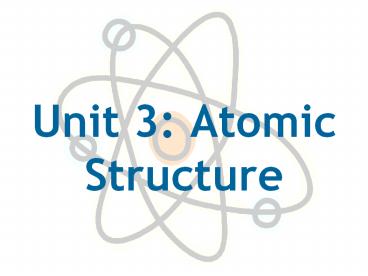Unit 3: Atomic Structure - PowerPoint PPT Presentation
1 / 16
Title:
Unit 3: Atomic Structure
Description:
Title: History of the Atom Author: Christopher Columbus Last modified by: Julie Ison Created Date: 10/25/1999 3:35:52 AM Document presentation format – PowerPoint PPT presentation
Number of Views:77
Avg rating:3.0/5.0
Title: Unit 3: Atomic Structure
1
Unit 3 Atomic Structure
2
History of the Atom
- Important Experiments Leading to Atomic Theory
3
Democritus (400 B.C.)
- A Greek philosopher
- Was the first person to think about an atoms
existence. - Believed that matter was composed of tiny
indivisible particles called atoms.
atomos
- He had no experimental evidence to support his
thoughts.
4
John Dalton (1766-1844)
- A meteorologist
- Unlike Democritus, he had experimental evidence
to support his theory. - Dalton had four major points (postulates) to his
theory.
5
Daltons Theory
- 1.) All elements are composed of indivisible
particles called atoms.
2.) Atoms of the same element are identical. The
atoms of any one element are different from those
of another.
6
Daltons Theory
3.) Atoms of different elements mix or combine in
whole number ratios. Example Oxygen combines
with hydrogen to form water in a 21 ratio.
4.) Chemical reactions occur when atoms separate,
join, or rearrange. In a chemical reaction,
atoms of one element NEVER change into another.
7
Joseph John (J.J.) Thompson (1859-1940)
Cathode Ray Tube Experiment
- In the tube was an inert gas, and two plates, a
positive and a negative. - The particles in the gas were attracted to the
positive plate. - Therefore, the particles MUST have a negative
charge. (Opposites attract.)
8
J.J. Thompson
- Discovered the electron.
- From his experimental evidence, he believed that
the atom was a solid positive sphere with
electrons shoved into the sides of it. - His model was said to resemble a popular English
dessert called Plum Pudding, and so his model was
deemed the Plum Pudding Model.
9
Ernest Rutherford click
- Used the gold foil experiment to discover the
nucleus. - Shot high energy beam of alpha particles into
gold foil.
10
Gold Foil Experiment
11
Ernest Rutherford Conclusions
Observation Conclusion
Most of the alpha particles went through he concluded
Few particles were deflected at small angles he concluded
Very rarely particles were deflected at large angles he concluded
The atom is mostly empty space
The alpha particle came close to something small
and positive (nucleus)
The alpha particles hit a small, very dense, and
positively charged center (nucleus)
12
Eugene Goldstein (1850-1930)
- Goldstein discovered the proton.
James Chadwick (1891-1974)
- Chadwick discovered the neutron.
13
Side note Not all of Daltons postulates were
correct.
- We now know that atoms are indeed divisible
atoms can be broken down into their subatomic
particles, protons, neutrons, and electrons (and
these too can be broken down even further!). - We also know that not all atoms of the same
element are identical. Isotopes exist for
different elements. (Well talk about this
later.)
14
Properties of Subatomic Particles
Particle Symbol Charge Relative Mass
1
p
1
Proton
0
1
n
Neutron
- -1
- e-
1/1840
Electron
15
Location of Particles
- Protons In the nucleus
- Neutrons In the nucleus
- Electrons In the electron cloud outside the
nucleus in energy levels
16
Neutral Atom
- An atom is considered neutral when it has the
same number of electrons and protons. - (p e-)































